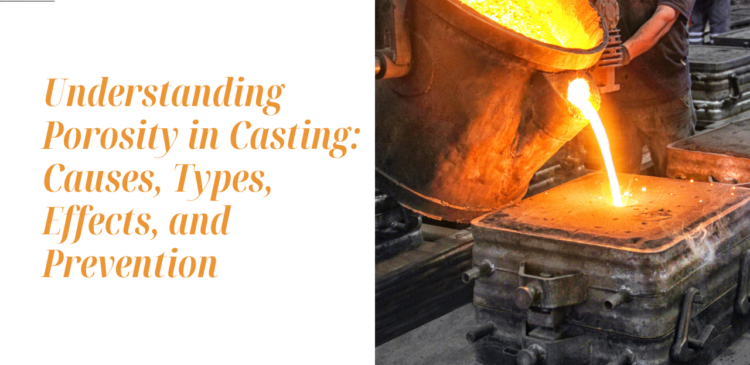Understanding Porosity in Casting: Causes, Types, Effects, and Prevention

Porosity in casting is a critical issue that can significantly impact the quality and performance of cast components. Addressing these problems is essential for ensuring the reliability and durability of parts produced through various casting processes.
What is Porosity in Casting?
Definition and Explanation
Porosity in casting refers to the presence of tiny holes or voids within the cast material. These voids can weaken the product, leading to potential failures in its application. Addressing porosity is crucial for maintaining casting quality and performance.
Types of Porosity in Casting
Gas Porosity in Casting
- Causes: Gas porosity occurs when gases become trapped in the molten metal during casting. This can happen due to rapid cooling, improper venting, or contamination.
- Effects: Gas porosity can compromise the structural integrity of the casting, leading to weak spots and potential failure under stress.
Shrinkage Porosity
- Causes: Shrinkage porosity results from the contraction of the metal as it solidifies. Inadequate feeding during the solidification process can cause this type of porosity.
- Impact: Shrinkage porosity affects the strength and performance of the casting, making it more susceptible to cracking and breaking.
Micro Porosity in Castings
- Description: Micro porosity consists of very small, often microscopic, voids within the cast material.
- Consequences: Micro porosity can affect the mechanical properties and surface finish of the casting, leading to reduced performance and aesthetic quality.
Porosity in Sand Casting
- Specific Causes: In sand casting, porosity can result from trapped gases, improper mold compaction, or moisture in the sand.
- Mitigation Methods: To reduce porosity in sand casting, ensure proper mold design, adequate venting, and control of moisture levels in the sand.
Porosity in Metal Casting
- Overview: Both gas porosity and shrinkage porosity are common in metal casting. The primary differences lie in their causes and the points in the casting process where they occur.
Common Casting Processes and Porosity Issues
Aluminum Casting Porosity
- Challenges: Aluminum casting is prone to gas porosity due to its high affinity for hydrogen.
- Prevention Techniques: Degassing the molten aluminum and controlling the cooling rate can help reduce porosity.
Die Casting Porosity
- Issues: Die casting can suffer from both gas and shrinkage porosity.
- Best Practices: Proper mold design, adequate venting, and maintaining consistent pressure during casting can minimize porosity.
Porosity in Gold Casting
- Challenges: Gold casting is susceptible to porosity, which can affect the quality and appearance of jewelry.
- Strategies: Using high-quality gold alloys and maintaining proper casting temperatures can reduce porosity defects.
Cast Iron Porosity
- Common Issues: Cast iron often experiences gas and shrinkage porosity.
- Solutions: Controlling the cooling rate and ensuring proper mold venting are essential in mitigating porosity in cast iron.
Detecting and Measuring Porosity
Visual Inspection
- Methods: Visual inspection is a simple and cost-effective method for detecting surface porosity. Look for visible holes or defects on the cast surface.
Non-Destructive Testing (NDT) Methods
- Techniques: X-ray, CT scanning, and ultrasonic testing are common NDT methods for identifying internal porosity.
- Advantages: These methods allow for detailed analysis without damaging the casting.
Microscopic Analysis
- Techniques: Microscopic examination can identify micro porosity and provide insights into its formation.
- Importance: Understanding micro porosity helps in improving casting processes and material quality.
Effects of Porosity on Casting Quality
Mechanical Properties
- Impact: Porosity can significantly weaken the tensile strength, fatigue resistance, and ductility of cast components.
Surface Finish
- Effects: Porosity affects the surface appearance, making the casting look rough and uneven.
Corrosion Resistance
- Influence: Porosity can create pathways for corrosive elements, reducing the corrosion resistance of the material.
Preventing and Reducing Porosity in Casting
Mold Design and Venting
- Importance: Proper mold design and venting are critical in allowing gases to escape and reducing porosity.
Controlling Cooling Rates
- Techniques: Managing cooling rates can prevent shrinkage porosity by ensuring uniform solidification.
Material Quality and Purity
- Role: Using high-quality materials and maintaining purity can minimize the occurrence of porosity defects.
Best Practices for Different Casting Processes
- Strategies: Specific strategies for aluminum, die casting, and sand casting include controlling the environment, proper mold design, and using appropriate additives.
Conclusion
Porosity in casting is a significant issue that can affect the performance and quality of cast components. By understanding its causes, types, and effects, manufacturers can implement effective prevention and detection methods to ensure high-quality castings.
FAQs
-
What is porosity in casting?
Porosity in casting refers to the presence of tiny holes or voids within the cast material, which can weaken the product and lead to failures in its application.
-
What causes porosity in casting?
Porosity can be caused by trapped gases (gas porosity), shrinkage during cooling (shrinkage porosity), and rapid solidification (micro porosity).
-
How does porosity affect the quality of castings?
Porosity can significantly weaken the structural integrity of castings, making them more prone to cracking, breaking, and corrosion.
-
What are the different types of porosity in casting?
The main types of porosity are gas porosity, shrinkage porosity, and micro porosity, each with distinct causes and effects.
-
How can porosity be prevented in casting processes?
Preventing porosity involves proper mold design, adequate venting, controlling the cooling rate, and using high-quality materials.
-
What are the best practices for detecting porosity in castings?
Detection methods include visual inspection, non-destructive testing (NDT) methods like X-ray or CT scanning, and post-casting treatments.
-
How does porosity impact the performance of cast components in different industries?
Porosity can affect the mechanical properties and reliability of cast components, making them unsuitable for critical applications in industries like automotive, aerospace, and medical.
